Read and download free pdf of CBSE Class 10 Science How Do Organisms Reproduce Worksheet. Students and teachers of Class 10 Science can get free printable Worksheets for Class 10 Science Chapter 7 How do Organisms Reproduce in PDF format prepared as per the latest syllabus and examination pattern in your schools. Class 10 students should practice questions and answers given here for Science in Class 10 which will help them to improve your knowledge of all important chapters and its topics. Students should also download free pdf of Class 10 Science Worksheets prepared by teachers as per the latest Science books and syllabus issued this academic year and solve important problems with solutions on daily basis to get more score in school exams and tests
Worksheet for Class 10 Science Chapter 7 How do Organisms Reproduce
Class 10 Science students should download to the following Chapter 7 How do Organisms Reproduce Class 10 worksheet in PDF. This test paper with questions and answers for Class 10 will be very useful for exams and help you to score good marks
Class 10 Science Worksheet for Chapter 7 How do Organisms Reproduce
Question. Like animals, plants produce
(a) many more sperm than eggs
(b) a few more sperm than eggs
(c) equal numbers of sperm and eggs
(d) fewer sperm than eggs
Answer : A
Question. Oral-contraceptives prevent the
(a) fertilization
(b) ovulation
(c) implantation
(d) entrance of sperms in vagina
Answer : B
Question. Which of the following helps in transport and nutrition of sperms?
(a) Mucus
(b) Blood
(c) Urine
(d) Glandular secretions
Answer : D
Question. Fertilization occurs in human beings in
(a) uterus
(b) ovary
(c) oviduct
(d) vagina
Answer : C
Question. Tunica albuginea is the covering around
(a) ovary
(b) testes
(c) kidney
(d) heart
Answer : B
True/False
Question. One advantage of sexual reproduction is that it allows for genetic sameness.
Answer : False
Question. The male germ-cell produced by pollen grain contains half the amount of DNA as compared to the other body cells of the plant.
Answer : True
Question. Transfer of male gametes to the stigma of flower is called pollination.
Answer : True
Question. Sexual reproduction involves two individuals for the creation of a new individual.
Answer : True
Question. Vegetative propagation produces plants that are genetically similar to the parent plant.
Answer : True
Question. At the time of birth, a baby girl has thousands of immature eggs.
Answer : True
Question. Basic event in reproduction is creation of DNA copy.
Answer : True
Question. In fission, many acteria and protozoa simply divide into two or more daughter cells.
Answer : True
Question. Sexual reproduction does not lead to variation in a population.
Answer : False
Question. The ovary of a flower grows into a fruit.
Answer : True
Question. Reproduction is not essential for an Individual but to maintain the species.
Answer : False
Question. The ovulation takes place 10-12 days after the start of menstruation.
Answer : True
Question. In mammals including man, fertilization takes place externally.
Answer : False
Question. Sexually transmitted diseases can be prevented by using condoms.
Answer : True
Question. Plasmodium multiplies by binary fission.
Answer : False
Question. Bryophyllum propagates through spore formation.
Answer : False
Question. Reproduction, unlike other life processes, is not essential to maintain the life of an individual organism.
Answer : True
Question. In human-beings, male can produce sperms upto the age of 45-50 years.
Answer : False
Very Short Answers
Question. Newly formed DNA copies may not be identical at times. Give one reason.
Answer : When a cell reproduces, DNA replication occurs which results in formation of two similar copies of DNA. The process of copying the DNA leads to some variations each time. As a result, the DNA copies produced are similar to each other but sometimes may not identical
Question. How do Plasmodium and Leishmania reproduce? Write one difference in their mode of reproduction.
Answer : Plasmodium and Leishmania reproduce by the process of fission which is an asexual mode of reproduction. Plasmodium reproduces by multiple fission. About 1000 daughter cells are produced by the multiple fission of a Plasmodium. Leishmania reproduces by the process of binary fission. In Leishmania, the splitting of parent cell takes place in a definite plane (longitudinally) with respect to flagellum at its end to produce two daughter cells.
Question. Define reproduction. How does it helps in providing stability to the population of species?
Answer : The production of new organisms by the existing organisms of the same species is known as reproduction. It is linked to the stability of population of a species. DNA replication during reproduction ensures transfer of specific characters or body design features that is essential for an individual of a population to live and use that particular niche. Some variations present in a few individuals of population caused due to reproduction which also helps in their survival at changing niches.
Question. How does the embryo gets nourishment from the mother?
Answer : Through placenta.
Question. What happens if egg is not fertilized?
Answer : If fertilization does not occur then menstruation occurs, i.e., blood and mucus comes out through thevagina.
Question. Name two ways of vegetative propagation practiced by gardeners.
Answer : Cutting and grafting.
Question. List two functions of ovary of human female reproductive system ?
Answer : Ovaries produces the ova or eggs and they produce hormones like oestrogen and progesterone. Oestrogen helps in development of secondary sexual characters in females at the time of puberty whereas progesterone prepares the uterus for receiving the fertilised egg.
Question. Name the method by which spirogyra reproduces under favourable conditions. Is this method sexual or asexual?
Answer : Spirogyra reproduces under favourable conditions by fragmentation which is an asexual mode of reproduction.
Question. State the method of growing rose plant and jasmine plant ?
Answer : Vegetative propagation like cutting is used to grow rose plant and layering method is used to grow jasmine plant.
Question. Name the largest cell present in the human body.
Answer : Ovum is the largest cell present in the, human body.
Question. Name the method by which Hydra reproduces ? Is this method sexual or asexual ?
Answer : Hydra can reproduce by budding and regeneration. Both are asexual method.
Question. Where is DNA found in cell?
Answer : DNA is found inside the nucleus in a cell.
Question. What is the significance of testes being located in scrotal sacs outside abdomen?
Answer : The formation of sperms requires a temperature of 2°C–3°C lower than body temperature. So testes are located in a sac like structures called scrotum outside the abdomen.
Question. How does Planaria reproduce? Is this method sexual or asexual?
Answer : Planaria reproduces by regeneration process. This method is an asexual mode of reproduction. In this process, if Planaria is cut into many pieces each piece grows into a new Planaria.
Question. Explain the roles of gamete and zygote in sexual reproduction?
Answer : Gametes play an important role in sexual reproduction because fusion of male and female gametes lead to formation of a zygote. Zygote formed as a result of fertilisation develops into embryo and finally into a new individual.
Question. Name a tiny fresh water animal which reproduces by the same method as that of yeast ? What is this method known as ?
Answer : Hydra is a tiny fresh water animal which reproduces by the same method as that of yeast and this method is known as budding.
Question. An organism which is a worm has very simple eyes, that are really eye spots which detect light. Name the organism.
Answer : Planaria.
Question. What is a clone? Why do offsprings formed by asexual reproduction exhibit remarkable similarity?
Answer : Clone is an exact replica of an organism produced as a result of asexual reproduction. Since all the offsprings formed by asexual reproduction have exact copies of DNA of their parent so they exhibit remarkable similarity.
Question. List two functions performed by testes in human beings.
Answer : In human testes, sperms are produced by the process of spermatogenesis and interstitial cells present in testes produce the male hormone testosterone.
Question. Name the causative agent of the disease kala-azar and its mode of asexual reproduction.
Answer : Leishmania causes kala-azar and its mode of asexual reproduction is binary fission.
Question. Name a unisexual and a bisexual flower.
Answer : Watermelon is an unisexual flower whereas Hibiscus is a bisexual flower.
Question. Name the causative organism of the disease “Kalaazar” and its mode of asexual reproduction.
Answer : Leishmania, Binary fission.
Question. Differentiate between germination and fertilization,
Answer : Germination: Development of embryo into a seedling. Fertilization: Fusion of male and female gametes.
Question. Regeneration is not possible in all types of animals. Why?
Answer : Regeneration is carried by specialised cells. The organisms which have those cells only can show regeneration.
Question. What is the advantage of reproducing through spores?
Answer : In the form of cyst, spore with a cell wall can survive in adverse conditions. They can be easily dispersed through wind as they are more in number and light in weight.
Short Answers
Question. Draw a labelled diagram of
a. Spore formation in Rhizop us
b. Multiple fission in Plasmodium.
Answer :
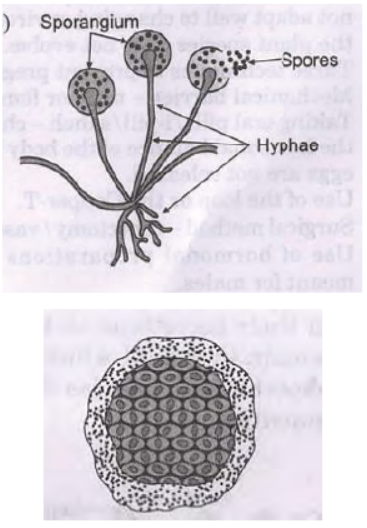
Question. Write two differences between binary fission and multiple fission in a tabular form as observed in the cells of the organisms.
Answer :

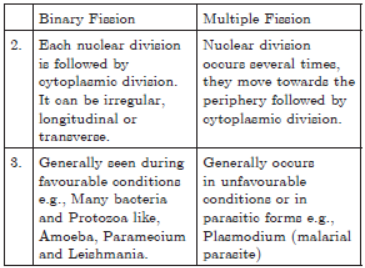
Question. Differentiate between plumule and radicle.
Answer :
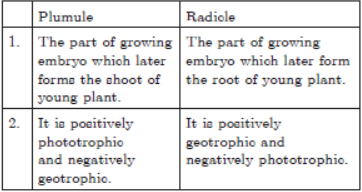
Question. Name the type of asexual reproduction in:
a. Planaria
b. Rhizopus
c. Spirogyra
d. Hydra
Answer : a. Regeneration
b. Spore formation
c. Fragmentation
d. Budding
Question. Label any four parts.
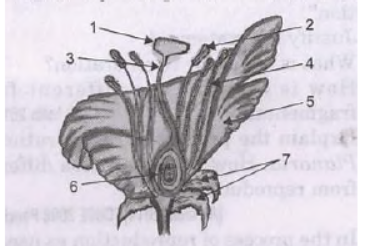
Answer : 1. Stigma
2. Anther
3. Style
4. Filament
5. Petal
6. Ovary
7. Sepal
Question. What are the functions of the following in male reproductive system?
a. Seminal vesicles
b. Prostate gland
Answer : a. In human males, seminal vesicles store sperms temporarily before ejaculation.
b. Both seminal vesicles and prostate gland add their secretions so that the sperms remain in a fluid which makes their transport easier and also this fluid provides nutrition.
Question. What is the main difference between sperms and eggs of human? Write the importance of this difference?
Answer : Sperms are motile and are produced in . large numbers by a male. Egg are non-motile and only one is produced at a time by the female. Sperms are motile as they have to travel up to egg for fertilization. It becomes zygote, remains protected inside female’s body and gives rise to foetus and baby.
Question. Draw labelled diagrams to illustrate budding in Hydra.
Answer : a. In sexual reproduction, fusion of male and female gametes takes place, these germ-cells/gametes contain half the number of chromosomes and by the fusion of these gametes the zygote is formed with full set of chromosomes.
b. When male and female gametes fuse at the time of fertilization, it restores the original number of chromosomes (of the parent), ensuring the stability of species.
Question. Leaves of Bryophyllum fallen on the ground produce new plants. Why?
Answer : Leaves of Bryophyllum bears adventi¬tious buds/ plantlets in the notches along the leaf margin. When the buds fall on the soil they develop into new plant under favourable condi-tions.
Question. Differentiate between self-pollination and crosspollination.
Answer :
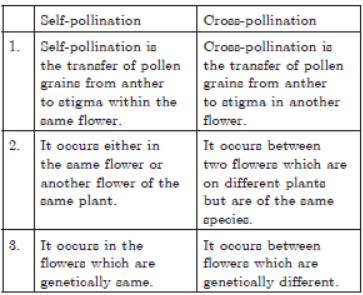
Question. What is meant by DNA copying? Mention its importance in reproduction.
Answer : Cells use chemical reactions to build copies of their DNA. This creates two copies of the DNA in a reproducing cell. DNA copying is accompanied by the creation of an additional cellular apparatus to facilitate the DNA copies to separate with its own cellular apparatus. DNA copying gives rise to some inbuilt tendency for variation during reproduction which is the basis for evolution.
Question. Distinguish between the functions of ovary and testis.
Answer :
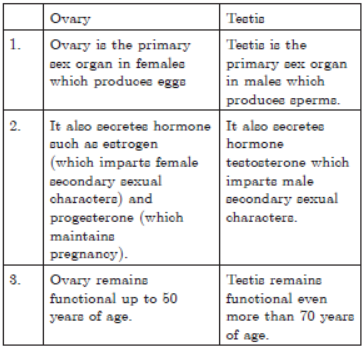
Question. Give reasons:
a. Wind acts as a pollinating agent.
b. Variation is essential and beneficial to a species.
c. Use of condoms prevents pregnancy.
Answer : a. Transfer of pollen grains from anther to stigma.
b. Helps in evolution and survival.
c. Prevents fertilization - Barrier method.
Question. DNA content has the tendency to double itself during sexual reproduction due to combining of the genetic materials from the two parents. How the problem of DNA doubling can be solved to maintain the consistency of the genetic material throughout the species?
or
“The chromosome number of the sexually reproducing parents and their offsprings is the same”. Justify the statement.
Answer : DNA doubling is always followed by cell division. Due to this special cell division, gametes form with half the content of DNA and single set of chromosomes. These gamete fuse to form zygote on fertilization. Thus the characteristic number of chromosome and the normal DNA content for a cell is regained.
Thus the consistency of the genetic material throughout the species is maintained and for the same reason the chromosome number of the sexually reproducing parents and their offsprings is the same.
Question. Explain the structure of the female reproductive system of humans.
Answer : Female Reproductive System consists of ovaries, fallopian tubes, uterus and vagina.
a. Ovaries are located inside the abdominal cavity, near the kidney. It performs two functions:
• Produce female germ - cells/eggs. Every month one egg is produced
• Secrete hormones like Estrogens which stimulate the development of secondary sexual characteristics at puberty.
b. Fallopian Tubes carry the egg from ovary to the womb; egg gets fertilized in the oviducts only if it meets a sperm.
c. Uterus is a elastic bag like structure. The fertilized egg, the zygote gets implanted in the fining of uterus and develops into an embiyo.
d. Vagina (Birth Canal) receives the sperms as well as child is borne through it.
Question. What are secondary sexual characters in humans? Name one such character of male and female.
Answer : The characters which distinguish a male from female are called secondary sexual characters. Secondary sexual characters of male are moustache, beard, thick growth of hair on body, strong muscles and harsh voice.
Secondary sexual characters of female are less hair on body, broad hips, development of breasts and soft voice.
Question. Give two examples each of the following:
a. Plants having unisexual flowers
b. Agents of pollination
c. Physical changes on puberty that are common to both boys and girls.
Answer : a. Papaya, watermelon
b. Insects, air, water, etc.
c. (i) Appearance of pubic hair.
(ii) Skin becomes oily and may develop pimples.
Question. Why are the testes located outside the abdominal cavity? Mention the endocrine and exocrine function of testes.
Answer : Sperm formation requires a lower temperature than the normal body temperature. This temperature is 1-3°C lower than the temperature of the body. Testes are thus located outside so that scrotum provides an optimal temperature for the formation of the sperms.
Endocrine function: Production of male hormone (testosterone).
Exocrine function: Production of male gametes (sperms).
Question. Name and explain the method by which Rhizopus reproduces.
Answer : Rhizopus reproduces by spore formation. Method: It is a method of asexual reproduction.
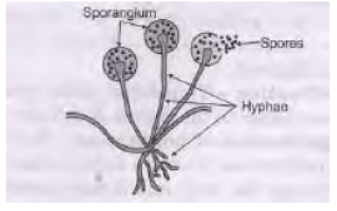
Spores are produced in a structure called sporangium.
Question. Write one main difference between asexual and sexual mode of reproduction. Which species is likely to have comparatively better chances of survival- the one reproducing sexually or the one reproducing asexually? Justify your answer.
or
How is sexual reproduction better than asexual reproduction?
Answer : a. Asexual reproduction does not involve genetic fusion while sexual reproduction involves fusion of male and female gametes to form a zygote.
b. Species reproducing sexually have better chances of survival.
Reason :
Sexual reproduction gives rise to more variations which are essential for evolution as well as survival of species under unfavorable conditions.
Question. What are chromosomes? Explain how in sexually reproducing organisms, the number of chromosomes in the progeny is maintained?
Answer : Chromosomes are thread like structures made-up of DNA found in the nucleus. The original number of chromosomes becomes half during gamete formation. Hence, when the gametes combine, the original number of chromosome gets restored in the progeny.
Long Answers
Question. Explain what happens when:
a. Testosterone is released in males.
b. Pollen grain falls on the stigma of the flower.
c. Egg fuses with sperm cell.
d. Planaria is cut into many pieces.
e. Buds are formed on the notches of the Bryophyllum leaf.
Answer : a. (i) Formation of sperms, change in appearance.
(ii) Thick hair growth on the face and voice begin to crack.
b. A tube grows out of the pollen grain and travel through the style to reach the ovary.
c. Zygote is formed (fertilization).
d. Each piece grows into a complete organism.
e. Buds may fall on the soil and develop into new plants.
Question. How does vegetative propagation occur in nature? Explain with four different examples.
Answer : There are many plants in which parts like the root, stem and leaves develop into new plants under appropriate conditions. This is called as vegetative propagation. Examples of vegetative propagation:
a. Adventitious buds: In Bryophyllum, adventitious buds grow in the notches along the leaf margin, which when fall on the soil, develop into new plants.
b. Cutting: A piece of stem, root, leaf or even a bulb scale is placed partly under moist soil which grows into a new plant, e.g., rose.
c. Layering: A part of the stem is pulled out and buried in the soil. The layered stem grows into a new plant, e.g., Pudina.
d. Grafting: In grafting, two parts from two different plants are joined together so that they can unite and grow into a new plant, e.g., sugarcane.
Question. a. Identify the organisms in figure A, B, C and D.
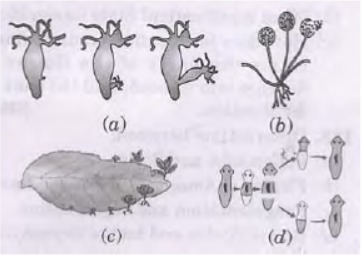
b. Identify the life process commonly shown in all the figures,
c. How is this life process .advantageous to the organisms? Mention any two advantages.
Answer : a. (A) Hydra (B) Rhizopus
(C) Bryophyllum (D) Planaria
b. Asexual mode of reproduction
c. (i) Only one individual is required.
(ii) Progeny is identical like parents
(iii) Produced in large number
Question. Identify the following methods and giving one example of each:
a. Process in which reproduction takes place by breaking up of parent into fragments.
b. Process of dividing of organisms into many cells simultaneously.
c. Process of reproduction by formation of bud on parent body.
d. Process of reproduction by formation of spores.
e. Process used by multicellular organisms to reproduce by cutting into many pieces each piece forms a new individual.
Answer : a. Fragmentation, Spirogyra
b. Multiple fission, Plasmodium
c. Budding, Hydra
d. Spore formation, Rhizopus
e. Regeneration, Planaria.
Reasoning Based Questions :
Question. Explain why fertilisation is possible if mating takes place during the middle of menstrual cycle?
Answer : Mostly in an healthy woman ovulation occurs on 14th day of 28 days menstrual cycle which is the middle day of the cycle hence if mating occurs in the middle of cycle there is maximum chance of fertilisation.
Question. Why is vegetative propagation practiced for growing some types of plants?
Answer : Vegetative propagation is practiced for growing some types of plants because:
(a) The plants which cannot produce seeds or produce nonviable seeds also can be easily propagated by this method.
(b) It is a very easy, quick and cheapest method of propagation.
(b) Seedless plants can be produced by vegetative propagation.
(d) Flowers and fruits are produced in very short time.
(e) Parental features are preserved.
Question. Why does menstruation occur in human females?
Answer : Menstruation occurs in human females when egg is not fertilised. Every month the ovary releases an egg and uterus prepares itself to receive the embryo. The wall of uterus gets thickened and they are richly supplied with blood which provides nutrition to the growing embryo from mother. If egg is not fertilised then there is no need of rich supply of blood and
thick lining of uterine wall and egg also disintegrates thus egg along with blood andmucus comes out through vagina in the form of menstrual flow.
Creating Based Questions :
Question. Mrs. Alka, 37 years old, was diagnosed with secondary infertility. The experts diagnosed her for tubal factor infertility that was obstructing her second pregnancy. Later, she was suggested to go for In-Vitro Fertilisation (IVF). She conceived in the first attempt of the treatment and delivered a healthy baby. Why it is difficult to conceive if fallopian tube is blocked?
Answer : In case the fallopian tube is blocked, the passage for sperm to get to the eggs, as well as the path back to the uterus for the fertilised egg, is blocked. To prevent pregnancy in females quite often the fallopian tube is blocked by surgery due to which the egg released by the ovary is not able to reach the uterus and hence fertilisation does not occur. If the fallopian tube is blocked then the female cannot conceive. The process of fertilisation starts in the fallopian tube hence if it is blocked then it is difficult for the female to get pregnant.
Question. Study the table given below and answer the questions.
(i) What are STDs?
(ii) What is the full form of HIV and AIDS?
(iii) Is syphilis a bacterial infection or a viral infection?
(iv) Is trichomoniasis a bacterial infection?
Answer : (i) There are a number of diseases that are caused by sexual intercourses. These diseases are called STDs “Sexually transmitted disease”.
(ii) The full form of HIV is the Human Immunodeficiency Virus, and the full form of AIDS is Acquired Immunodeficiency Syndrome.
(iii) The syphilis is a bacterial infection as it is caused by a bacteria named Treponema pallidum.
(iv) No, trichomoniasis is not a bacterial infection as it caused by a protozoan named Trichomoniasis vaginalis.
Question. Elaborate the statement ‘DNA contains the blueprint of the next generation’.
Answer : DNA is the hereditary material. It stores the blueprint in the genes which are the sequence of nucleotides. Genes control synthesis of proteins. These proteins act as enzymes which control biochemical reactions of the body. Genes are responsible for transmitting characters from parents to offspring. Before transmitting characters from parents to offspring prior to cell division DNA makes its copies by replication. Hence, DNA contains the blueprint of the next generation.
Question. Due to his recent travel and the location of sores, Dr. Gonzala suspects that Mike may have contracted Leishmaniasis.
(i) Name the parasite that causes Leishmaniasis.
(ii) The parasite that causes Leishmaniasis reproduce through which mode?
(iii) How it is transmitted?
Answer : (i) Leishmaniasis infection caused by the parasite Leishmania.
(ii) Leishmania reproduce through binary fission.
(iii) Leishmania is transmitted through the bite of an infected sand-fly. Leishmania (which cause kala-azar), have a whiplike structure at one end of the cell.
Question. The diagram represents gametes P and Q fusing to give cell R. This cell then produces gametes S.T.U and V.
(i) State whether P, Q and R are Haploid or diploid.
(ii) What is the Ratio of Number of Chromosomes in a Human Zygote and a Human Sperm?
(iii) The parental cell divides and gives rise to two daughter cells. Each division doubles the number of cells. How many numbers of cells will be there in third generation? If starting cells is considered as 0 generation.
Answer : (i) P and Q are haploid gametes while R is zygote and diploid.
(ii) The number of chromosomes in a human sperm is half the number of chromosomes in a zygote i.e their ratio is 2:1
(iii) The number of cells increases exponentially and can be expressed as 2n, where n is the number of generations. If we apply the formula 2n, where n is equal to 3, the single cell
would give rise to 23 i.e 8 cells.
Question. A 25-year-old young man with his partner of 3 years decides not to have babies and undergoes a surgical procedure to prevent pregnancy. This led to permanent sterilisation of young mam.
(i) Name the surgery performed.
(ii) Which part is cut during this process?
(iii) How does this process prevent pregnancy?
Answer : (i) Vasectomy is a surgical procedure for male sterilisation or permanent contraception.
(ii) During the procedure, the male vasa deferentia are cut and tied or sealed.
(iii) Cutting and sealing of vasa deferentia prevents sperm from entering into the urethra and thereby prevent fertilisation of a female through sexual intercourse.
| CBSE Class 10 Chemistry Chemical Reactions And Equations Worksheet Set A |
| CBSE Class 10 Chemistry Chemical Reactions And Equations Worksheet Set B |
| CBSE Class 10 Science Acids Bases And Salts Worksheet Set A |
| CBSE Class 10 Science Acids Bases And Salts Worksheet Set B |
| CBSE Class 10 Chemistry Metals And Non Metals Worksheet Set A |
| CBSE Class 10 Chemistry Metals And Non Metals Worksheet Set B |
| CBSE Class 10 Physics Electricity Worksheet Set A |
| CBSE Class 10 Physics Electricity Worksheet Set B |
| CBSE Class 10 Science Electricity Worksheet |
Worksheet for CBSE Science Class 10 Chapter 7 How do Organisms Reproduce
We hope students liked the above worksheet for Chapter 7 How do Organisms Reproduce designed as per the latest syllabus for Class 10 Science released by CBSE. Students of Class 10 should download in Pdf format and practice the questions and solutions given in the above worksheet for Class 10 Science on a daily basis. All the latest worksheets with answers have been developed for Science by referring to the most important and regularly asked topics that the students should learn and practice to get better scores in their class tests and examinations. Expert teachers of studiestoday have referred to the NCERT book for Class 10 Science to develop the Science Class 10 worksheet. After solving the questions given in the worksheet which have been developed as per the latest course books also refer to the NCERT solutions for Class 10 Science designed by our teachers. We have also provided a lot of MCQ questions for Class 10 Science in the worksheet so that you can solve questions relating to all topics given in each chapter.
You can download the CBSE Printable worksheets for Class 10 Science Chapter 7 How do Organisms Reproduce for latest session from StudiesToday.com
There is no charge for the Printable worksheets for Class 10 CBSE Science Chapter 7 How do Organisms Reproduce you can download everything free
Yes, studiestoday.com provides all latest NCERT Chapter 7 How do Organisms Reproduce Class 10 Science test sheets with answers based on the latest books for the current academic session
CBSE Class 10 Science Chapter 7 How do Organisms Reproduce worksheets cover all topics as per the latest syllabus for current academic year.
Regular practice with Class 10 Science worksheets can help you understand all concepts better, you can identify weak areas, and improve your speed and accuracy.

